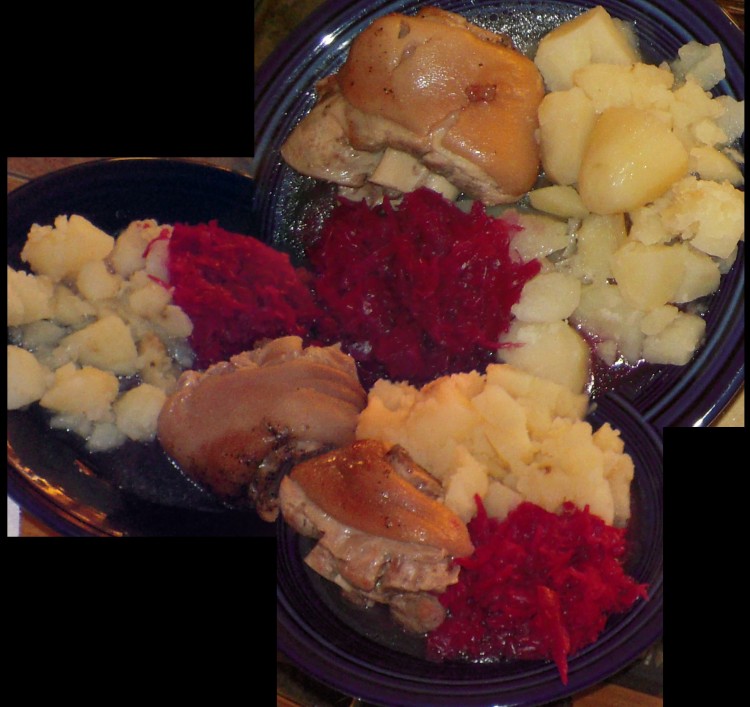Our Usinger’s Wurst order arrived today, so we had German pork products for dinner. This is a place we always wanted to order from for Christmas, but thought better to first do a trial run to make sure things are up to cut. Fred Usinger, Inc. is located in Milwaukee – a pretty good meat city – though I have to say I was a bit disappointed. As many of you know, I always make my base order from Karl Ehmer, and then add a few things from another butcher. Ehmer’s offers free shipping, which saves you money even though the products are pricier. Note that I paid an amount for shipping and handling equal to what I shelled out for actual products from Usinger’s, which is standard everywhere but Ehmer’s. The reason I keep sniffing at the door of other companies is to find the perfect Leberwurst. Karl Ehmer’s is good, but, like many brands, is too heavy on the cure and/or smoke for me. After awhile I find this sickening. I want to taste the liver, I want it to be moist, and I don’t want to taste TCM. I also like it chunky, or grob. Next, I am looking for the Grobe Mettwurst of my childhood – an almost spreadable, tangy, coarse, cured pork sausage product that might be lightly smoked, if at all. Something like this may be had in the form of Grobe Teewurst, which is really a spread, from places like Schaller & Weber and Ehmer’s, but it’s not really the same thing. Some meat packers even call Teewurst Mettwurst, which is an outrage. Speaking of outrage, Karl Ehmer sells Canadian Bacon as Nuss Schinken! Madness. Back to the illusive Mettwurst. You have to know your stuff to find this, and you will only be able to come close, since it cannot be legally sold in the US in its original form, according to some of my German butcher friends. In many cases, sausage close to Mettwurst is sold in the US as summer sausage, but there are so many varieties of the latter that trial and error is not a good way to go. Call the meat packer and ask for one of the butchers from Germany and he’ll be able to steer you. For example, the Schaller & Weber people told me that the closest they come to my fantasy is cervelat, which is pretty damned good. Anyway, we ordered a small quality of each of six liverwursts, a smoked Mettwurst, and a few other things from Usinger’s. Everything arrived well packed and frozen solid. I was a little concerned about the frozen part. Allow me to give you a rundown and review:
Tongue and blood: Good. Plenty of tongue. The downside is the heavy smoke flavor. They made a mistake and sliced it when we ordered a chunk. Some in our party were not amused by this, since slicing destroys the texture.
Braunschweiger liverwurst: Unremarkable. Springy, perhaps from being frozen or not having enough fat. It tore. Not bad on the cure/smoke end of things, but not much flavor.
Milwaukee-style liverwurst: Ditto. Could not really tell the difference from the non-Milwaukee version.
Hessische liverwurst: The only liverwurst that was truly distinctive. Pretty good, and heavily smoked, but it worked here. More creamy than dry.
Old-fashioned liverwurst: Not really chunky, though they said it would be. Same review as the Braunschweigers.
Ring liverwurst: My mother’s favorite, and a bit more flavorful and creamy.
Bavarian leberkaese: This is a loaf made of pork puree that’s baked and then sliced thickly. Good, but dense. If you want it lighter get it from Ehmer’s or another butcher.
Topfsuelze: No idea, as they sent head cheese by mistake, which is much sharper (more vinegar) and comes in a tube, as opposed to a square. I was seriously pissed off about this. When I called they said they’d send the right one out to me or provide a credit. Nice people, but my nose was out of joint because this is my favorite thing in the whole world, and I didn’t get any. Not all chopped pork jowl-area scrap meat in aspic is the same, after all. The head cheese was tasty, though, as it had plenty of tongue and other good bits, so it wasn’t a total loss. Steven really liked it, partly because it cut through the heaviness of some of the other items.
Mettwurst, coarse, smoked: Almost like kielbasa, so it did not work for me. It’s hard to find the real deal because of the FDA regulations involving the sale of cured meat.
Beef, Farmer & Thueringer summer: All fine. The beef has some tang to it. Texture is firm. These are like salamis.
Bottom line is that Usinger’s products are good, but tailored to the American palate, in my opinion. The liverwursts come across as less rich in taste and texture — more like top supermarket versions. They are also less unique as individuals, whereas there is no question with Ehmer’s, Schaller & Weber, Koenemann’s and Stiglemeier that you know which one you are dealing from first bite, if not sight. I like that the smoke and cure flavors are less pronounced in all cases but the Hessische – which is by nature heavily smoked – but not enough to pay for that kind of shipping, given other issues. Berry liked all of it – even the head cheese, which he grabbed after I dropped a piece on the floor and it bounced away from me. Even I have to admit this is kind of scary.


